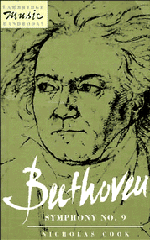5 - The twentieth-century Ninth
Published online by Cambridge University Press: 08 January 2010
Summary
The purely musical Ninth
In Opera and Drama, which was written in 1850–51, Wagner pursues an involved argument about the nature of melody. He contrasts the organic nature of folksong with the mechanical complication of the operatic aria. He argues that true melody is shaped from union with words, and not according to the arbitrary patterns of so-called musical form. And he suggests that, in the Ninth Symphony. Beethoven actually embodies this process of melodic shaping in the music. He is referring, of course, to the ‘Joy’ theme.
Though only in the progress of his tone-piece, does the master set his full melody before us as a finished whole, yet this melody is to be subsumed as already finished in the artist's mind from the beginning. He merely broke at the outset the narrow Form, … he shattered it into its component parts, in order to unite them by organic creation into a new whole; and this he did, by setting the component parts of different melodies in changeful contact with each other, as though to show the organic affinity of the seemingly most diverse of such parts, and therewith the prime affinity of those different melodies themselves.
Wagner is saying that the relationship of its various melodic materials to the ‘Joy’ theme gives the Ninth Symphony an underlying coherence – a real form beneath the surface form, so to speak. At least, this is what Alexander Serov, Wagner's Russian disciple, understood him to be saying.
- Type
- Chapter
- Information
- BeethovenSymphony No. 9, pp. 81 - 99Publisher: Cambridge University PressPrint publication year: 1993



